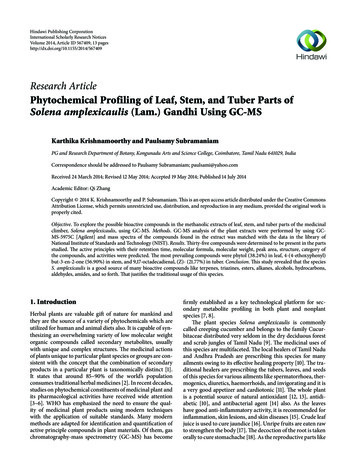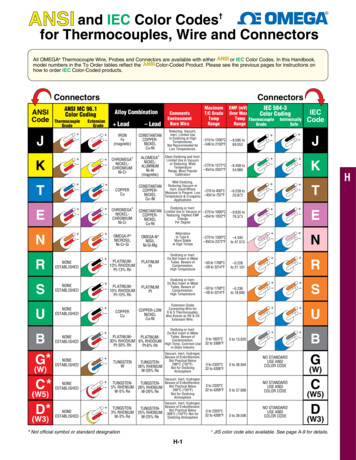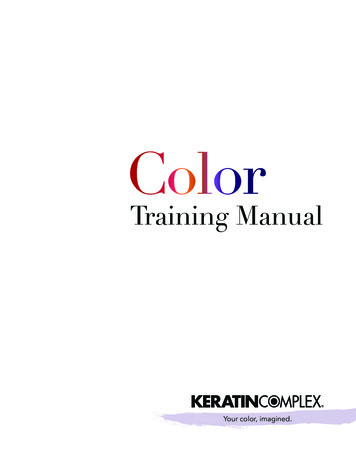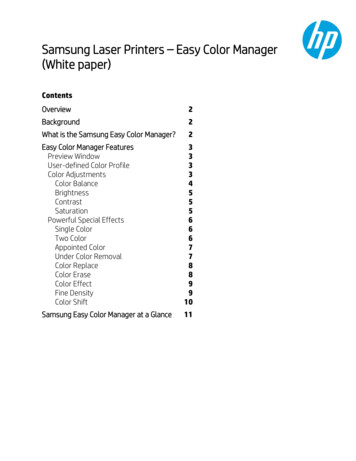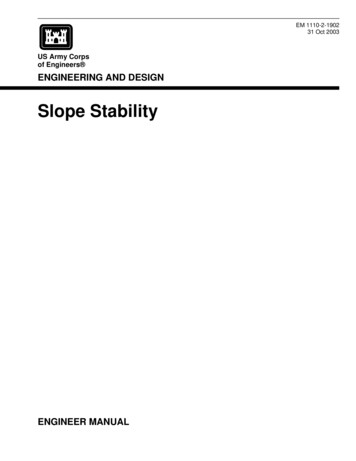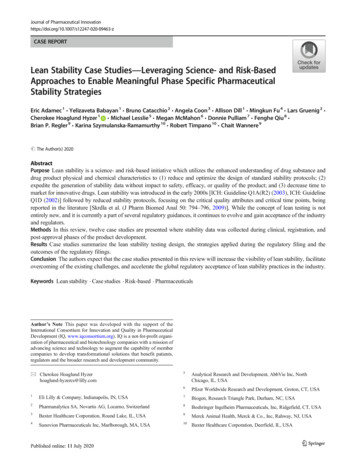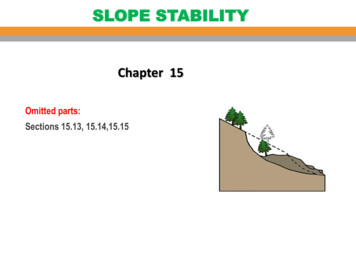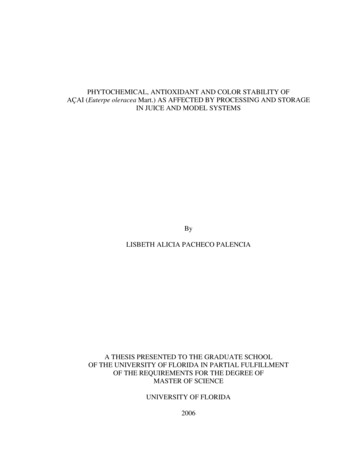
Transcription
PHYTOCHEMICAL, ANTIOXIDANT AND COLOR STABILITY OFAÇAI (Euterpe oleracea Mart.) AS AFFECTED BY PROCESSING AND STORAGEIN JUICE AND MODEL SYSTEMSByLISBETH ALICIA PACHECO PALENCIAA THESIS PRESENTED TO THE GRADUATE SCHOOLOF THE UNIVERSITY OF FLORIDA IN PARTIAL FULFILLMENTOF THE REQUIREMENTS FOR THE DEGREE OFMASTER OF SCIENCEUNIVERSITY OF FLORIDA2006
Copyright 2006byLisbeth Alicia Pacheco Palencia
Dedicated to those that have guided and inspired me.
ACKNOWLEDGMENTSI want to express my infinite gratitude to my advisor, Dr. Stephen Talcott, for theguidance and support that made all this work possible. I also thank my advisingcommittee, Dr. Steven Sargent and Dr. Marty Marshall, for the valuable time devoted tothis project. I am ever so grateful to my lab mates and friends, Youngmok, Chris, Lanier,Lorenzo, Flor and Jorge, for their support and for making the lab such an enjoyableexperience. I am greatly indebted to Dr. Joon Hee Lee, for sharing her knowledge andvaluable time with me.I would never be able to thank enough my family for the unconditional love andsupport that have always accompanied me. To my mom Eugenia, my brothers Luis Pabloand Kevin, my grandparents Albertina and Manuel, my aunt Claudia and uncles Luis andAdolfo, I owe my most sincere and deep gratitude.Finally, my dearest thanks to Jolián, for all the support, care and happinessbrought to my life.iv
TABLE OF CONTENTSpageACKNOWLEDGMENTS . ivLIST OF TABLES. viiiLIST OF FIGURES . ixABSTRACT. xiiCHAPTER1INTRODUCTION .12LITERATURE REVIEW .42.1 Açai Market and Distribution .42.2 Açai Fruit .52.2.1 Occurrence.52.2.2 Morphology .52.2.3 Production.52.2.4 Uses and Composition.62.3 Polyphenolics.72.3.1.1 Phenolic acids.82.3.1.2 Flavonoids .92.3.1.3 Tannins .112.3.2 Polyphenolics as Antioxidants .132.3.3 Polyphenolics in Açai.142.4 Anthocyanins .152.4.1 Structure and Occurrence .152.4.2 Color stability .182.4.2.1 Structural and concentration effects .182.4.2.2 pH .192.4.2.3 Temperature .202.4.2.4 Oxygen .202.4.2.5 Light .202.4.2.6 Enzymes .202.4.2.7 Sugars .212.4.2.8 Ascorbic acid.212.4.2.9 Copigmentation .22v
2.4.3 Anthocyanins in Açai .233PHYTOCHEMICAL, ANTIOXIDANT AND PIGMENT STABILITY OF AÇAIAS AFFECTED BY CLARIFICATION, ASCORBIC ACID FORTIFICATIONAND STORAGE .243.1 Introduction.243.2 Materials and Methods .253.2.1 Materials and Processing.253.2.2 Chemical Analysis.263.2.2.1 Spectrophotometric determination of total anthocyanins.263.2.2.2 Determination of polymeric anthocyanins .263.2.2.3 Determination of total soluble phenolics .263.2.2.4 Quantification of antioxidant capacity .273.2.2.5 Analysis of polyphenolics by HPLC .273.2.3 Statistical Analysis .283.3 Results and Discussion .283.3.1 Anthocyanin Color Retention.283.3.2 Polymeric Anthocyanins Concentration.333.3.3 Total Soluble Phenolics.353.3.4 Polyphenolics by HPLC .383.3.4.1 Anthocyanins by HPLC .383.3.4.2 Non anthocyanin polyphenolics by HPLC.433.3.5 Antioxidant Capacity.473.4 Conclusions.494MATRIX COMPOSITION AND ASCORBIC ACID FORTIFICATION EFFECTSON THE PHYTOCHEMICAL, ANTIOXIDANT AND PIGMENT STABILITYOF AÇAI .514.1 Introduction.514.2 Materials and Methods .534.2.1 Materials and Processing.534.2.2 Chemical Analysis.554.2.3 Statistical Analysis .554.3 Results and Discussion .554.3.1 Anthocyanin Color Retention.554.3.2 Polymeric Anthocyanins Concentration.634.3.3 Total Soluble Phenolics.664.3.4 Polyphenolics by HPLC .704.3.4.1 Anthocyanins by HPLC .704.3.4.2 Non-anthocyanin polyphenolics by HPLC .754.3.5 Antioxidant Capacity.784.4 Conclusions.815SUMMARY AND CONCLUSIONS .83vi
LIST OF REFERENCES.85BIOGRAPHICAL SKETCH .955vii
LIST OF TABLESTablepage3-1Clarification and ascorbic acid (AA) fortification effects on kinetic parametersof color degradation in açai juice stored at 4 and 20 C. .323-2Clarification and ascorbic acid (AA) fortification effects on kinetic parametersof anthocyanin degradation in açai juice stored at 4 and 20 C. .434-1Kinetic parameters for color degradation in ascorbic acid (AA) fortified andnon-fortified açai fractions stored at 37 C. .594-2Kinetic parameters for color degradation in açai juice as affected by the presenceof non-anthocyanin polyphenolics (NAP), ascorbic acid addition and storage .614-3Kinetic parameters for total anthocyanin (HPLC) degradation in ascorbic acid(AA) fortified and non-fortified açai fractions stored at 37 C.74viii
LIST OF FIGURESFigurepage2-1Basic flavonoid structure.102-2General structure of condensed tannins. .112-3Chemical structures of some flavan-3-ols: ( )-Gallocatechin (A), (-)Epigallocatechin (B) and (-)-Epigallocatechin 3-O-gallate (C). .122-4Chemical structures of the most abundant anthocyanidins. .162-5Four main equilibrium forms of anthocyanins in aqueous media: flavyliumcation, quinonoidal base, carbinol- or anhydrobase and chalcone .193-1Total anthocyanin content of açai as affected by clarification and fortificationwith ascorbic acid (AA) during storage at 4 C .293-2Total anthocyanin content of açai as affected by clarification and fortificationwith ascorbic acid (AA) during storage at 20 C .303-3Linear regression of total anthocyanin content of açai as affected byclarification, fortification with ascorbic acid (AA) and storage at 4 C. .313-4Polymeric anthocyanins (%) in açai as affected by clarification and fortificationwith ascorbic acid (AA) during storage at 4 C .333-5Polymeric anthocyanins (%) in açai as affected by clarification and fortificationwith ascorbic acid (AA) during storage at 20 C .343-6Total soluble phenolics (%) in açai as affected by clarification and fortificationwith ascorbic acid (AA) during storage at 4 C .363-7Total soluble phenolics (%) in açai as affected by clarification and fortificationwith ascorbic acid (AA) during storage at 20 C .373-8HPLC chromatogram of anthocyanins in açai juice. Compounds were tentativelyidentified as cyanidin-3-glucoside (A) and cyanidin-3-rutinoside (B) .393-9Total anthocyanin content (HPLC) of açai as affected by clarification andfortification with ascorbic acid (AA) during storage at 4 C .40ix
3-10 Total anthocyanin content (HPLC) of açai as affected by clarification andfortification with ascorbic acid (AA) during storage at 20 C .413-11 Linear regression of total anthocyanin content (HPLC) of açai as affected byclarification, fortification with ascorbic acid (AA) and storage at 4 C. .423-12 HPLC chromatogram of polyphenolics present in açai juice: catechin (A),procyanidin (B), chlorogenic acid (C), (-)epicatechin (D).443-13 Phenolic content (HPLC) of açai as affected by clarification and fortificationwith ascorbic acid (AA) during storage at 4 C .453-14 Phenolic content (HPLC) of açai as affected by clarification and fortificationwith ascorbic acid (AA) during storage at 20 C .463-15 Antioxidant capacity (%) of açai as affected by clarification and fortificationwith ascorbic acid (AA) during storage at 4 C .483-16 Antioxidant capacity (%) of açai as affected by clarification and fortificationwith ascorbic acid (AA) during storage at 20 C .494-1Açai juice fractionation process. .544-2Linear regression of total anthocyanin content for non-fortified açai fractions asaffected by storage at 37 C. .564-3Total anthocyanin content of non-fortified açai fractions as affected by storageat 37 C. Error bars represent the standard error of the mean, n 3.574-4Total anthocyanin content of ascorbic acid fortified (500mg/L) açai fractions asaffected by storage at 37 C .584-5Polymeric anthocyanins (%) in non-fortified açai fractions as affected by storageat 37 C. Error bars represent the standard error of the mean, n 3.644-6Polymeric anthocyanins (%) in ascorbic acid fortified (500mg/L) açai fractionsas affected by storage at 37 C .654-7Total soluble phenolics (%) in non-fortified açai fractions as affected by storageat 37 C. Error bars represent the standard error of the mean, n 3.674-8Total soluble phenolics (%) in ascorbic acid fortified (500mg/L) açai fractionsas affected by storage at 37 C .694-9Linear regression analysis of total anthocyanin content (HPLC) for non-fortifiedaçai fractions as affected by storage at 37 C.714-10 Total anthocyanin content (HPLC) of non-fortified açai fractions as affected bystorage at 37 C. Error bars represent the standard error of the mean, n 3. .72x
4-11 Total anthocyanin content (HPLC) of ascorbic acid fortified (500mg/L) açaifractions as affected by storage at 37 C .734-12 Phenolic content (HPLC) of non-fortified açai fractions as affected by storage at37 C. Error bars represent the standard error of the mean, n 3.764-13 Phenolic content (HPLC) of ascorbic acid fortified (500mg/L) açai fractions asaffected by storage at 37 C .774-14 Antioxidant capacity (%) of non-fortified açai fractions as affected by storage at37 C. Error bars represent the standard error of the mean, n 3.794-15 Antioxidant capacity (%) of ascorbic acid fortified (500mg/L) açai fractions asaffected by storage at 37 C .80xi
Abstract of Thesis Presented to the Graduate Schoolof the University of Florida in Partial Fulfillment of theRequirements for the Degree of Master of SciencePHYTOCHEMICAL, ANTIOXIDANT AND COLOR STABILITY OFAÇAI (Euterpe oleracea Mart.) AS AFFECTED BY PROCESSING AND STORAGEIN JUICE AND MODEL SYSTEMSByLisbeth Alicia Pacheco PalenciaMay 2006Chair: Stephen T. TalcottMajor Department: Food Science and Human NutritionAçai (Euterpe oleracea Mart.), a palm fruit native to the Amazon region, hasrecently captured the attention of US consumers due to its novelty and potential healthbenefits associated with its high antioxidant capacity and polyphenolic composition.However, studies on the functional properties of this matrix and their stability duringprocessing and storage are still lacking. These studies were undertaken to assess thepolyphenolic and pigment stability of açai as affected by juice clarification, ascorbic acidfortification and storage and to determine matrix composition effects on thephytochemical and color stability of açai in both natural and model juice systems.The results of clarification (non clarified, centrifuged and filtered açai pulp),ascorbic acid fortification (0 and 500 mg/L), and storage (4 and 20 C) on thephytochemical, antioxidant, and color stability of açai were evaluated through a storageperiod of 30 days. Matrix composition effects on açai stability were further assessed in axii
study that compared natural juice systems with isolated fractions following ascorbic acidaddition (0 and 500 mg/L) and storage (37ºC). Polyphenolic and anthocyanin fractionswere isolated using C18 Sep-Pak mini-columns and redissolved in buffer (pH 3.5) or inthe original aqueous matrix (C18 unbound). Samples were analyzed during a storageperiod of 12 days. Chemical analyses for both studies included total anthocyanin content,polymeric anthocyanin concentration, total soluble phenolics, antioxidant capacity andpolyphenolics by HPLC.Treatments stored at 4 C showed the highest stability for all variables measured bythe end of the storage period. Clarification of açai pulp was responsible for initial lossesin color (20%), total phenolics (25%), total anthocyanins (25%) and antioxidant capacity(20%). Ascorbic acid fortification markedly accelerated anthocyanin degradation in theclarified juice although no significant effects were observed in the non-clarified orcentrifuged açai pulp. Losses in antioxidant activity were correlated to total anthocyanin(r 0.88) and phenolic (r 0.73) contents in both clarified and non-clarified treatments. Ina second study, complex interactions among matrix components considerably influencedpolyphenolic, antioxidant and color stability in açai juice and juice fractions. Colorretention was favored by anthocyanin isolation while the retention of non-anthocyaninpolyphenolics was enhanced by the natural juice matrix. Major losses occurred during thefirst 4 days of storage (37 C) in all treatments while in fortified fractions, the presence ofnon-anthocyanin polyphenolics exerted a protective effect against ascorbic acidoxidation. Maximum polyphenolic, antioxidant and pigment stability of açai products canbe achieved if processing parameters are carefully controlled and low storagetemperatures (4 C) are maintained throughout the distribution chain.xiii
CHAPTER 1INTRODUCTIONConsumption of fruits and vegetables has been associated with lowered incidenceof various degenerative diseases including cancer and coronary heart disease (Van Poppeland others 1994; Burda and Oleszek 2001). The presence of phytochemicals such asflavonoids and other polyphenolics is thought to contribute to the protective effects and isgenerally associated with the antioxidant activity of these compounds (Chun and others2005). Açai (Euterpe oleracea Mart.), one of the most abundant species in the Amazonestuary floodplains (Muñiz-Miret and others 1996), has captured the attention of USconsumers in recent years due to its unique flavor, novelty and potential health benefits,possibly derived from its polyphenolic composition.Polyphenolics are naturally occurring substances in plants, thought to have benefitson human health (Haysteen 1983; Bravo 1998; DiCarlo and others 1999; Burda andOleszek 2001). Beneficial health effects of plant polyphenolics have been recognized tooriginate from its capability to inhibit oxidative degradation (Roginsky and Lissi 2005)hence, minimizing losses during processing is of particular interest. The stability ofpolyphenolic compounds present in açai has not been previously assessed and associatedchanges in antioxidant activity and functional properties are unknown. Among them,anthocyanins, members of the flavonoid group of phenolic compounds and the mostabundant group of naturally occurring pigments in plants, have emerged as importantalternatives to synthetic colorants (Kong and others 2003) while its high antioxidantactivity and inhibitory effects on cancer cell growth has been indicated in several studies1
2(Renaud and De Lorgeril 1992; Wang and others 1997; Muth and others 2000; Tsuda andothers 2000; Hou 2003). However, high raw material costs and poor stability duringprocessing and storage considerably limit their industrial applications. Anthocyaninstability is considerably affected by structure, concentration, pH, light, temperature, thepresence of copigments, metallic ions, oxygen, ascorbic acid, sugars, proteins and sulfurdioxide (Rodriguez-Saona and others 1999). Açai may constitute a novel source of thesenatural pigments and potential exists for its application as a functional ingredient in juiceblends, functional and sport beverages, dairy products, desserts and as a dietarysupplement. However, its stability during processing and storage has not been assessedand the conditions that favor detrimental changes in both color and functional propertieshave not been identified.The edible pulp of açai fruits is commonly macerated with water to produce thethick puree of the same name, widely popular throughout the northern countries of SouthAmerica (Strudwick and Sobel 1988). Further processing steps may includepasteurization, freezing, dilution, clarification, fortification and dehydration.Fortification of various fruit juices, nectars or purees with ascorbic acid is a commonpractice in the industry, not only to maintain quality while preventing browning reactionsbut also to enhance nutritional value (Freedman and Francis 1984). However, combiningascorbic acid with anthocyanins, naturally occurring in açai, has been shown to bemutually destructive, causing losses in color, functional properties and nutritional quality(Garcia-Viguera and Bridle 1999). Furthermore, phytochemical and matrix compositioneffects on açai polyphenolics and color stability in the presence of ascorbic acid have notbeen evaluated.
3The present studies assessed clarification, fractionation, fortification and storageeffects on antioxidant capacity, phytochemical content and pigment stability of açai. Itwas hypothesized that juice clarification would not affect polyphenolic stability whereasthe presence of ascorbic acid would be detrimental for both polyphenolic and pigmentstability. Additionally, isolated anthocyanin fractions would show decreased stabilitywhile the presence of naturally occurring polyphenolics would significantly improvecolor, antioxidant capacity and phytochemical stability. The specific objectives of thesestudies were To evaluate the antioxidant capacity, polyphenolic composition and pigmentstability of açai as affected by juice clarification and fortification with L-ascorbicacid. To determine the effects of naturally occurring matrix components on thepolyphenolic, antioxidant capacity and color stability of açai in the presence ofascorbic acid. To determine storage time and temperature effects on the color and pigmentstability of açai.
CHAPTER 2LITERATURE REVIEW2.1 Açai Market and DistributionAçai (Euterpe oleracea Mart) is a widely distributed palm in northern SouthAmerica, attaining its greatest coverage and economical importance in the state of Pará,Brazil (Sergio and others 1999). The fruit of açai is a primary staple food for the region’sinhabitants and according to Anderson (1988) its harvesting accounts for more than 60%of the forest products sold by a single family. Locally, fruits are used in several disheslike ice cream, pies, and jelly although a major product is a drink obtained from the coldmaceration of its pulp. The beverage, also known as açai in the Amazonian region, is adark purple juice of creamy texture, slightly oily appearance, and characteristic nuttyflavor that contains a high anthocyanin and polyphenolic content (Muñiz-Miret andothers 1996).Due to its highly perishable nature, consumption and expanded commercializationof açai had long been restricted to a purely regional level in South America. According toClay and Clement (1993) the market for açai in 1990, entirely domestic to SouthAmerica, was nearly US 100 million. The main local market for the fruit is in Belém,Pará, where as many as 50,000 kg of unprocessed fruits are sold daily (Rogez 2000).In the United States, interest in açai has intensified in recent years, due toincreased import, its novel characteristics and potential health benefits associated with itshigh antioxidant capacity, derived from its rich anthocyanin content and polyphenoliccomposition. Consumer trends toward health and wellness have favored açai markets in4
5the form of juice drinks as well as a source of functional pigments and flavors for thefood industry (Pszczola 2005). Currently, açai exists in US markets in a variety of formsincluding juices, nutraceutical beverages, and dietary supplements with excellentpotential for its application as a functional ingredient in desserts, dairy, and organicproducts.2.2 Açai Fruit2.2.1 OccurrenceAçai is mainly found in the Amazon River estuary, covering an area ofapproximately 25,000 km2. It is especially common on perennially flooded, black or clearwater forest swamps. Population density is considered to be high at 2,500 to 7,500plants/hectare but varies depending on soil conditions (Clay and Clement 1993).2.2.2 MorphologyAçai is a slender, multistemmed, monoecious palm that can have more than 45stems in different stages of growth, fruit development, and ripeness stage and trees canreach a height of over 25 meters. Fruit bunches per plant vary from 3 to 4 and producefrom 3 to 6 kg of fruit per year (Clay and Clement 1993). Fruits are rounded, measuringfrom 1 to 1.4 centimeters in diameter, are purple, almost black when mature and appearin clusters. The seed comprises approximately 80% of the total volume and is covered byfibrous layers and a thin, slightly oily coating under which is a small edible layer (Rogez2000).2.2.3 ProductionFruiting occurs throughout the year, however, due to geographical variations infruit ripening, heavy seasonal production occurs between July and December (MuñizMiret and others 1996). Harvesting the fruit bunches is an arduous and frequently
6dangerous task, done by individuals accustomed to climbing the açai palms using a fiberring to support their feet. A practiced harvester moves from one stem to another, withoutdescending, until all ripe fruit bunches from a clump have been manually removed andcollected in a basket. Fruits are then separated from the bunches and selected based ontheir firmness and color by the same harvesters, who can collect up to 180 kg in a day ofwork. Fruits are finally transported to the markets and commercialized in less than 24 h,to prevent significant nutritional and quality losses (Rogez 2000).An estimated 180,000 tons of fruit are produced annually, limited only by demandsince until recently, the high perishability of the fruits had restricted its consumption to apurely regional level (Rogez 2000).2.2.4 Uses and CompositionAçai produces a wide variety of market and subsistence products while more than22 different uses for all plant parts have been reported (Anderson 1988). However, theprincipal use is for the preparation of a thick, dark purple beverage obtained by coldmaceration of its ripe fruits. In the process, water is incorporated to facilitate extractionand increase yields. The most important trade qualities are based on total solids and are“grosso” (14% total solids), “medio” (11%) and “fino” (8%). Açai is locally popularthroughout all socioeconomic levels, and in Belém, Pará, an individual daily consumptionof up to 2 L has been reported (Rogez 2000).Nutrient content has been previously reported by Mota (1946), Campos (1951) andAltman (1996) (cited by Clay and Clement 1993), as follows: 1.25-4.34% (dry weight)protein, 7.6-11.0% fats, 1-25% sugar, 0.050% calcium, 0.033% phosphorous, 0.0009%iron, and traces of sulphur and vitamins A and B1. Additionally, it is characterized by ahigh caloric content, ranging from 88 to 265 calories per 100 g, depending upon the
7dilution. Few studies have been conducted on açai juice (Bobbio and others 2002; Araujoand others 2004; Del Pozo-Insfran and others 2004) and data on its composition andfunctional properties are still lacking.2.3 PolyphenolicsVascular plants synthesize a diverse array of secondary metabolites, commonlyreferred to as phenolics. The term encompasses more than 8000 naturally occurringcompounds,
Requirements for the Degree of Master of Science PHYTOCHEMICAL, ANTIOXIDANT AND COLOR STABILITY OF AÇAI (Euterpe oleracea Mart.) AS AFFECTED BY PROCESSING AND STORAGE IN JUICE AND MODEL SYSTEMS By Lisbeth Alicia Pacheco Palencia May 2006 Chair: Stephen T. T
